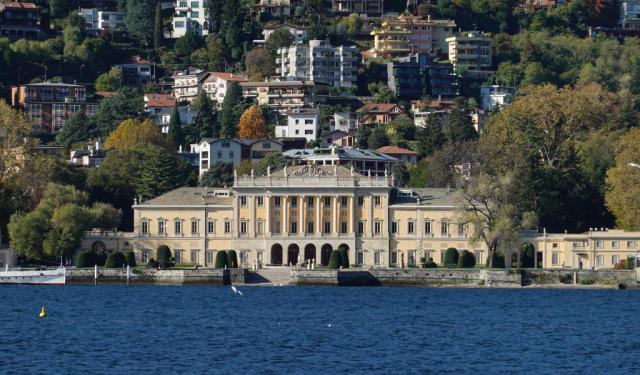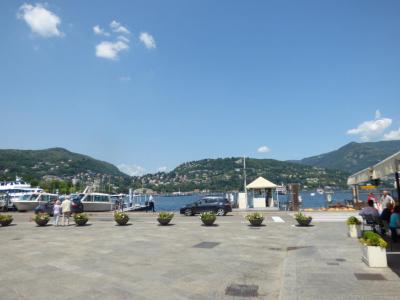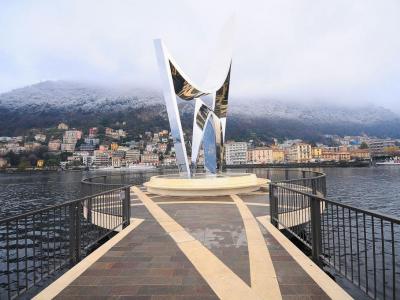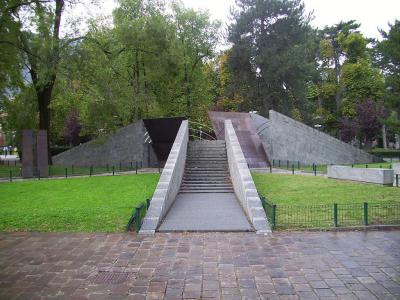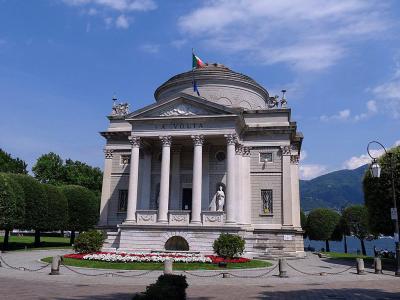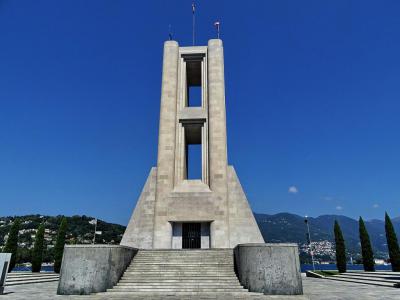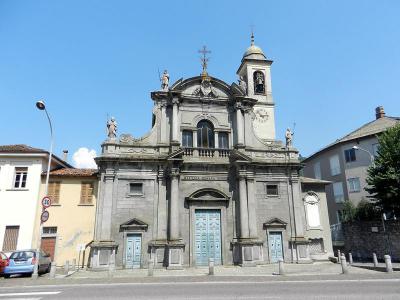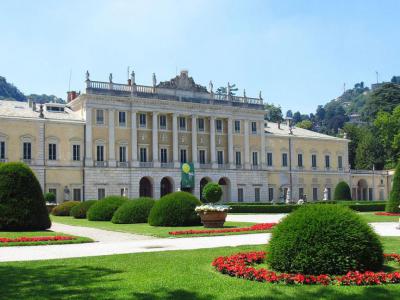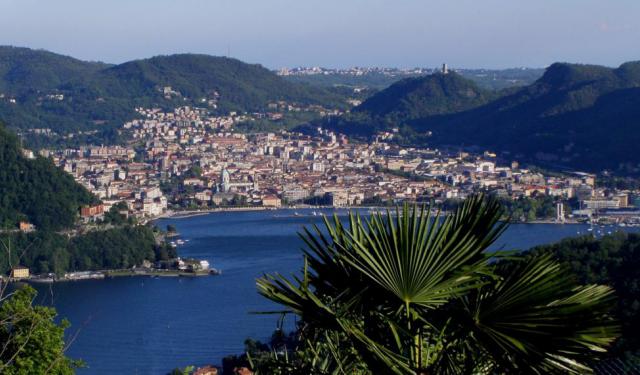Como Lakeshore Walking Tour (Self Guided), Como
English novelist Mary Shelley declared visitors to Italy are in danger of becoming: "enjoyers of the beauties of nature, the elegance of art, the delights of climate, the recollections of the past, and the pleasures of society." All this she found on the shores of Lake Como. From Roman writer Pliny the Younger onward, visitors and natives of Como would have agreed.
The alpine lake is shaped like the Chinese symbol "person" or an inverted letter "Y." Como nestles in the toe of the left leg. The city of Lecco is at the bottom of the right leg. The Como lakeshore is famous for the handsome villas and mansions that line its shores.
The lakeshore has an international ambiance. Along the shore promenade, one encounters an upscale marina and a hydroplane "airport." Swimming and water sports are great, and numerous wayside paths invite hiking in the hills. A lakeshore walk is best starting from the Piazza Cavour, a great meeting place and convenient to the promenade.
Among the grand villas, palaces, and monuments on the shore is the Tempio Voltiano, a neoclassical monument honoring Alessandro Volta, inventor of the electric battery and a native of Como. The modernistic Life Electric monument also honors Volta. At one end of the harbor are the lush gardens of Villa Olmo, a palace and museum.
One can visit attractions around the lake by hopping on and off any of the many boats and ferries. The neoclassical Volta Museum is on the shore near the futurist War Memorial to the Fallen. Near the museums are the lakeside gardens, a popular place for strolling. The gardens are a venue for festivals and musical events.
Mary Shelly wrote about her "Rambles" in Italy. She maintained nothing lifted her spirits more than hearing Italian and descending the alpine slopes to Lake Como.
The alpine lake is shaped like the Chinese symbol "person" or an inverted letter "Y." Como nestles in the toe of the left leg. The city of Lecco is at the bottom of the right leg. The Como lakeshore is famous for the handsome villas and mansions that line its shores.
The lakeshore has an international ambiance. Along the shore promenade, one encounters an upscale marina and a hydroplane "airport." Swimming and water sports are great, and numerous wayside paths invite hiking in the hills. A lakeshore walk is best starting from the Piazza Cavour, a great meeting place and convenient to the promenade.
Among the grand villas, palaces, and monuments on the shore is the Tempio Voltiano, a neoclassical monument honoring Alessandro Volta, inventor of the electric battery and a native of Como. The modernistic Life Electric monument also honors Volta. At one end of the harbor are the lush gardens of Villa Olmo, a palace and museum.
One can visit attractions around the lake by hopping on and off any of the many boats and ferries. The neoclassical Volta Museum is on the shore near the futurist War Memorial to the Fallen. Near the museums are the lakeside gardens, a popular place for strolling. The gardens are a venue for festivals and musical events.
Mary Shelly wrote about her "Rambles" in Italy. She maintained nothing lifted her spirits more than hearing Italian and descending the alpine slopes to Lake Como.
How it works: Download the app "GPSmyCity: Walks in 1K+ Cities" from Apple App Store or Google Play Store to your mobile phone or tablet. The app turns your mobile device into a personal tour guide and its built-in GPS navigation functions guide you from one tour stop to next. The app works offline, so no data plan is needed when traveling abroad.
Como Lakeshore Walking Tour Map
Guide Name: Como Lakeshore Walking Tour
Guide Location: Italy » Como (See other walking tours in Como)
Guide Type: Self-guided Walking Tour (Sightseeing)
# of Attractions: 7
Tour Duration: 1 Hour(s)
Travel Distance: 2.1 Km or 1.3 Miles
Author: DanaOffice
Sight(s) Featured in This Guide:
Guide Location: Italy » Como (See other walking tours in Como)
Guide Type: Self-guided Walking Tour (Sightseeing)
# of Attractions: 7
Tour Duration: 1 Hour(s)
Travel Distance: 2.1 Km or 1.3 Miles
Author: DanaOffice
Sight(s) Featured in This Guide:
- Piazza Cavour (Cavour Square)
- Life Electric
- Monumento alla Resistenza Europea (Monument to the European Resistance)
- Tempio Voltiano (Volta Temple)
- Monumento ai Caduti (Monument to the Fallen)
- Basilica di San Giorgio (St. George's Basilica)
- Villa Olmo
1) Piazza Cavour (Cavour Square) (must see)
Cavour Square sits where Como’s old town fades into the lakefront-a stage that’s seen more reinventions than some opera houses. In the Middle Ages, this patch of ground was little more than a swamp. Fast forward to the 19th century, when Como decided its waterfront needed a facelift, and suddenly the marsh became a plaza worthy of national pride. They named it after Camillo Benso, Count of Cavour, one of the masterminds behind Italian unification-joining the other illustrious Como personalities.
From here, the lake does its best impression of a painting. Boats slide across the water, the hills rise up green and steep, and if you squint, you can spot the Volta Lighthouse on the far ridge. To the west, the 1846 Hotel Metropole Suisse presides with its quiet confidence, while the east side offers the sort of cafés, trattorias, and gelato counters that can delay even the most determined sightseeing schedule. Street performers often add their own soundtrack, just in case the place wasn’t lively enough.
The square also knows how to party. Each June, swing bands bring back the 1930s and ’40s for the Swing Crash Festival. December transforms it into a Christmas market, all lights and wooden stalls. And year-round, it serves as a launchpad: ferries to the lake towns, the cathedral a short stroll away, the funicular to Brunate just along the promenade.
As far as plazas are concerned, they are a meeting point. The best Count of Cavour role play is to reunite with your friends and close ones by breathing in the forever changing atmosphere of this square . Beware of the seagulls, for they might steal your gelato.
From here, the lake does its best impression of a painting. Boats slide across the water, the hills rise up green and steep, and if you squint, you can spot the Volta Lighthouse on the far ridge. To the west, the 1846 Hotel Metropole Suisse presides with its quiet confidence, while the east side offers the sort of cafés, trattorias, and gelato counters that can delay even the most determined sightseeing schedule. Street performers often add their own soundtrack, just in case the place wasn’t lively enough.
The square also knows how to party. Each June, swing bands bring back the 1930s and ’40s for the Swing Crash Festival. December transforms it into a Christmas market, all lights and wooden stalls. And year-round, it serves as a launchpad: ferries to the lake towns, the cathedral a short stroll away, the funicular to Brunate just along the promenade.
As far as plazas are concerned, they are a meeting point. The best Count of Cavour role play is to reunite with your friends and close ones by breathing in the forever changing atmosphere of this square . Beware of the seagulls, for they might steal your gelato.
2) Life Electric
Life Electric is a modern sculpture dedicated to physicist and inventor of the electric battery Alessandro Volta. The structure, completed in 2015, is the work of master architect and virtuoso accordion player Polish-American Daniel Libeskind. Life Electric was commissioned by the non-profit association "The Friends of Como."
Life Electric is located on the very end of the Breakwater pier (Diga Foranea), consolidated before the construction. The inauguration ceremony took place in October 2015. It was attended by Libeskind and his family, Luigi Martino, a nephew of Volta, and actress-model Nastassja Kinski. The dock is accessible from Lake Road (Mafalda of Savoy). The location lends greater visibility to the sculpture.
Life Electric is inspired by the electric tension between the two poles of a battery. It establishes a third pole between Volta Lighthouse (Faro Voltiano) and the Volta Temple museum (Templo Voltiano). The sculptor has created a geometric connection of the sky, lake, and mountains surrounding Lake Como. The interaction between these three elements produces an immense geometric power as a metaphor for Volta's electric power.
The structure is 49 feet tall from the base. It consists of two opposing sinusoidal curves. At the bottom is a containment wall around a pool 25 inches deep. The monument is made of calendered steel covered with steel panels. The illumination system using smoke machines creates light games at night.
Life Electric is located on the very end of the Breakwater pier (Diga Foranea), consolidated before the construction. The inauguration ceremony took place in October 2015. It was attended by Libeskind and his family, Luigi Martino, a nephew of Volta, and actress-model Nastassja Kinski. The dock is accessible from Lake Road (Mafalda of Savoy). The location lends greater visibility to the sculpture.
Life Electric is inspired by the electric tension between the two poles of a battery. It establishes a third pole between Volta Lighthouse (Faro Voltiano) and the Volta Temple museum (Templo Voltiano). The sculptor has created a geometric connection of the sky, lake, and mountains surrounding Lake Como. The interaction between these three elements produces an immense geometric power as a metaphor for Volta's electric power.
The structure is 49 feet tall from the base. It consists of two opposing sinusoidal curves. At the bottom is a containment wall around a pool 25 inches deep. The monument is made of calendered steel covered with steel panels. The illumination system using smoke machines creates light games at night.
3) Monumento alla Resistenza Europea (Monument to the European Resistance)
Gianni Colombo is a sculptor and protagonist of post-World War II contemporary art. He was invited in the 1980s to submit a project for a memorial to victims of the war. He created a monument that was "not only visible but livable."
Three separate staircases go up to an "absent" center. From here may be seen leaning metal tablets inscribed with bits of notes written by people condemned to death in the concentration camps of World War II. The steps, as well as the metal tablets, are inclined at different angles. This lining upsets the sense of balance of the visitor.
This imbalance creates a state of paresthesia and physical amazement. The monument, therefore, becomes a livable space that produces a collective bewilderment meant to induce a dialogue on Resistance. Translations of the notes in seven languages are provided on the marble slabs alongside the stairs.
Stones taken from the various death camps and the city of Hiroshima are also included in the monument. The memorial, located in Como city park, was inaugurated in May 1983 by Italy's then President, Sandro Pertini.
Three separate staircases go up to an "absent" center. From here may be seen leaning metal tablets inscribed with bits of notes written by people condemned to death in the concentration camps of World War II. The steps, as well as the metal tablets, are inclined at different angles. This lining upsets the sense of balance of the visitor.
This imbalance creates a state of paresthesia and physical amazement. The monument, therefore, becomes a livable space that produces a collective bewilderment meant to induce a dialogue on Resistance. Translations of the notes in seven languages are provided on the marble slabs alongside the stairs.
Stones taken from the various death camps and the city of Hiroshima are also included in the monument. The memorial, located in Como city park, was inaugurated in May 1983 by Italy's then President, Sandro Pertini.
4) Tempio Voltiano (Volta Temple) (must see)
Francesco Somaini, owner of a cotton mill in Como and Member of Parliament, had the idea of building a place devoted to the memory of Alessandro Volta, the great physicist and inventor of the electrical battery, to preserve his scientific tools and documents. Somaini had seen the fire that destroyed much of the Great Exhibition pavilions in 1936. The fire took with it artifacts associated with the works of Alessandro Volta.
Somaini had the resources, and architect Federico Frigerio started the project "to honor a man who was among the brightest glories of the Napoleonic era." He designed the building in a Neoclassic architectural style. The Volta Temple museum was illustrated on the 10,000 Liras bill.
The museum building was completed in 1927 to commemorate the 100th anniversary of the scientist's death. It was donated to the city by Francesco Somaini. The Volta Temple is located on the beautiful lakefront of Como, between the War Memorial and the Monument to European Resistance.
It has a raised portico supported by six free-standing fluted Corinthian columns inspired by the Pantheon of Agrippa in Rome. There is a triangular pediment above the portico. A cylindrical dome covers the main chamber. The museum hosts a collection of instruments used by Volta, including his voltaic piles (batteries).
Somaini had the resources, and architect Federico Frigerio started the project "to honor a man who was among the brightest glories of the Napoleonic era." He designed the building in a Neoclassic architectural style. The Volta Temple museum was illustrated on the 10,000 Liras bill.
The museum building was completed in 1927 to commemorate the 100th anniversary of the scientist's death. It was donated to the city by Francesco Somaini. The Volta Temple is located on the beautiful lakefront of Como, between the War Memorial and the Monument to European Resistance.
It has a raised portico supported by six free-standing fluted Corinthian columns inspired by the Pantheon of Agrippa in Rome. There is a triangular pediment above the portico. A cylindrical dome covers the main chamber. The museum hosts a collection of instruments used by Volta, including his voltaic piles (batteries).
5) Monumento ai Caduti (Monument to the Fallen)
Antonio Sant'Elia was a futurist visionary architect and soldier who died in 1916 in the battle of Monfalcone. Born in Como, his urban design featured modernity, dynamics, and speed. Some drawings from his book, "New City," showing vistas of multi-level skyscraper cities, are kept at Villa Olmo in Como.
The Monument to the Fallen is on Como's lakeshore, next to the Volta Temple. Its design is based on a pencil and watercolor sketch of a lighthouse by Antonio Sant'Elia, done in 1912. Sant'Elia himself is one of the 650 fallen remembered in the monument.
In 1930, Futurist scenographer Enrico Prampolini was asked to adapt a sketch by Sant'Elia to that of a monument. Prampolini's 10-foot colonnade version was rejected by the fascist mayor. The work was taken over by architect Giuseppe Terragni, with the support of his brother, Attilio Terragni, the mayor of Como. Made of Serizzo granite and Nabresina marble, the monument has a surface polished like a mirror and shows that the Terragni has skillfully adapted Sant'Elia's vision. The Monument to the Fallen was inaugurated in November 1933.
The memorial is a futuristic Ziggurat. From a massive pedestal, four columns frame rectangular openings. The pedestal has two symmetrical entrances with inscriptions. "The city exalts her sons with stones from Carso, 1915-1918," faces the city. "This night, we sleep in Trieste or Paradise among the heroes," overlooks Lake Como.
The interior holds a granite monolith with the names of the fallen. There is a sepulchral chapel, a crypt, staircases, and an elevator.
The Monument to the Fallen is on Como's lakeshore, next to the Volta Temple. Its design is based on a pencil and watercolor sketch of a lighthouse by Antonio Sant'Elia, done in 1912. Sant'Elia himself is one of the 650 fallen remembered in the monument.
In 1930, Futurist scenographer Enrico Prampolini was asked to adapt a sketch by Sant'Elia to that of a monument. Prampolini's 10-foot colonnade version was rejected by the fascist mayor. The work was taken over by architect Giuseppe Terragni, with the support of his brother, Attilio Terragni, the mayor of Como. Made of Serizzo granite and Nabresina marble, the monument has a surface polished like a mirror and shows that the Terragni has skillfully adapted Sant'Elia's vision. The Monument to the Fallen was inaugurated in November 1933.
The memorial is a futuristic Ziggurat. From a massive pedestal, four columns frame rectangular openings. The pedestal has two symmetrical entrances with inscriptions. "The city exalts her sons with stones from Carso, 1915-1918," faces the city. "This night, we sleep in Trieste or Paradise among the heroes," overlooks Lake Como.
The interior holds a granite monolith with the names of the fallen. There is a sepulchral chapel, a crypt, staircases, and an elevator.
6) Basilica di San Giorgio (St. George's Basilica)
The Saint George's Basilica is located on the road to Cernobbio in the Como suburb of Borgovico. The religious edifice is an odd grafting of the Romanesque and Baroque architectural styles. The Baroque elements were added to the original plain Romanesque structure.
The church was built around 1075 in the Lombard-Romanesque style with three naves, a portico, and an attached cemetery. There were three apses; a wide central apse and two shallower side apses. The central apse held five niches. Frescoes were added in 1081. In the center of the presbytery are the remains of the sepulcher of Saint Eutichio.
Extensive renovations took place in the 17th century. The facade was finished in granite, and the basic structure was reinforced against flooding. Architect Giovanni Battista Recchi completed the exterior of the church. Agostino Silva, an architect from Ticino, introduced massive square columns in support of the central nave and transept.
The restorations between 1876 and 1925 led to the revelation of underground rooms and ancient frescoes in the five niches of the central apse. The frescoes, threatened with water damage in the 1960s, were restored and put on exhibition again. In 2003, they were moved to two rooms of the Civic Art Gallery of Volpi Palace.
The church was built around 1075 in the Lombard-Romanesque style with three naves, a portico, and an attached cemetery. There were three apses; a wide central apse and two shallower side apses. The central apse held five niches. Frescoes were added in 1081. In the center of the presbytery are the remains of the sepulcher of Saint Eutichio.
Extensive renovations took place in the 17th century. The facade was finished in granite, and the basic structure was reinforced against flooding. Architect Giovanni Battista Recchi completed the exterior of the church. Agostino Silva, an architect from Ticino, introduced massive square columns in support of the central nave and transept.
The restorations between 1876 and 1925 led to the revelation of underground rooms and ancient frescoes in the five niches of the central apse. The frescoes, threatened with water damage in the 1960s, were restored and put on exhibition again. In 2003, they were moved to two rooms of the Civic Art Gallery of Volpi Palace.
7) Villa Olmo (must see)
Villa Olmo is a neoclassic jewel on a grand scale, dating from the 18th century, designed by Swiss architect Simone Cantoni. The Villa Olmo was a summer palace for the Italian noble family Odescalchi. It is the most sumptuous and celebrated of Como residences. The building was named for the gigantic elm tree in the front garden.
The Villa Olmo had two gardens; an Italian in front and an English park in the back. According to legend, Pliny the Younger, a native of Como, planted the great elm as he created the park around the mansion.
The original central neoclassical part of the building is raised and faced with massive columns decorated with depictions of Plato, Solon, Thales, Socrates, and Pythagoras, created by sculptor Francesco Carabelli. Inside, an immense atrium, three floors high, takes up the entire area of the Villa. An enormous arch leads to a grand staircase.
After the Atrium is the ballroom with a pavilion vault holding frescoes by 18th-century artist Domenico Pozzi showing the Gods of Olympus. Beyond the ballroom are a series of rooms dedicated to reception and conversation. They are decorated with stuccos and gildings and are named for Greek Goddess Dionysus, Ariadne, and Artemis. On the second floor, mythological adornments fill the rooms honoring Olympus. There is also a medallion depicting the Apotheosis of Heracles.
Innocenzo Odescalchi, the first owner, enlarged the building and added wings. Among the notable guests of the Villa Olmo was Napoleon in 1797, emperors of Austria Francis II and Ferdinand I in 1816, 1826, and 1838, the poet Ugo Foscolo in 1808, and the general Giuseppe Garibaldi in 1859.
A portico, two balconies, and a small theatre were added under the ownership of Marquis Guido Visconti. The garden park was rearranged, and the ground floor stuccos were refurbished. Since 1924, the Villa Olmo has been owned by the City of Como, which has kept it as a venue for cultural events.
The Villa Olmo had two gardens; an Italian in front and an English park in the back. According to legend, Pliny the Younger, a native of Como, planted the great elm as he created the park around the mansion.
The original central neoclassical part of the building is raised and faced with massive columns decorated with depictions of Plato, Solon, Thales, Socrates, and Pythagoras, created by sculptor Francesco Carabelli. Inside, an immense atrium, three floors high, takes up the entire area of the Villa. An enormous arch leads to a grand staircase.
After the Atrium is the ballroom with a pavilion vault holding frescoes by 18th-century artist Domenico Pozzi showing the Gods of Olympus. Beyond the ballroom are a series of rooms dedicated to reception and conversation. They are decorated with stuccos and gildings and are named for Greek Goddess Dionysus, Ariadne, and Artemis. On the second floor, mythological adornments fill the rooms honoring Olympus. There is also a medallion depicting the Apotheosis of Heracles.
Innocenzo Odescalchi, the first owner, enlarged the building and added wings. Among the notable guests of the Villa Olmo was Napoleon in 1797, emperors of Austria Francis II and Ferdinand I in 1816, 1826, and 1838, the poet Ugo Foscolo in 1808, and the general Giuseppe Garibaldi in 1859.
A portico, two balconies, and a small theatre were added under the ownership of Marquis Guido Visconti. The garden park was rearranged, and the ground floor stuccos were refurbished. Since 1924, the Villa Olmo has been owned by the City of Como, which has kept it as a venue for cultural events.
Walking Tours in Como, Italy
Create Your Own Walk in Como
Creating your own self-guided walk in Como is easy and fun. Choose the city attractions that you want to see and a walk route map will be created just for you. You can even set your hotel as the start point of the walk.
Como Introduction Walking Tour
The Roman writer Pliny the Younger once wrote to his friend, “What is the news from Como, mine and your delight?” Como is a place of palaces, churches, gardens, temples, museums, and parks. Its nearness to the spectacular Lake Como and the Swiss and Italian Alps has made the area a traveler’s delight from the time of Pliny the Younger to the present day.
Pliny wasn’t its first fan,... view more
Tour Duration: 2 Hour(s)
Travel Distance: 2.6 Km or 1.6 Miles
Pliny wasn’t its first fan,... view more
Tour Duration: 2 Hour(s)
Travel Distance: 2.6 Km or 1.6 Miles
The Most Popular Cities
/ view all
